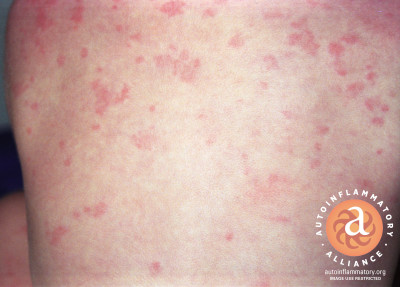Familial Cold Autoinflammatory Syndrome (NLRP3-AID-mild)
Acronym:
FCAS (NLRP3-AID-mild)
SAID group:
Cryopyrin Associated Periodic Syndromes (CAPS) NLRP3-associated Autoinflammatory Diseases (NLRP3-AID)
Gene:
NLRP3
Inheritance:
Autosomal dominant. Many large family groups spanning generations. Some patients with spontaneous mutations. [1]
Ethnicity:
Affects all races, but many are of European descent. [1]
Frequency:
1:1 million, or more. In USA 300+ diagnosed – most cases are from large family groups. [2], [5] Frequency of CAPS in France is 1:360,000. [55]
Timing of symptoms:
12-24 hours, or longer. Onset of fever and flares is often 1-3 hours after exposure to cold or cooling temperatures. [1]
Age of onset:
Infancy, but a few present with symptoms later in childhood or adolescence. [1]
Skin cutaneous:
Cold-induced, urticaria-like rash with increased neutrophils at the eccrine coils. [4] Almost daily rash that increases with flares. [1] Ice cube test negative. A few with apthous ulcers.
Neurologic:
Some have headaches and fatigue with fever after cold exposure. It is unknown if there are any other effects on the central nervous system (CNS) at this time. [1]
Auditory:
Some patients have mild hearing loss – not currently known if it‘s from CAPS inflammation. [1]
Ophthalamic:
Conjunctivitis (non-infectious) during flares. [1]
Cardiopulmonary:
Not noted. [1]
Abdominal:
Uncommon. [1]
Lymphatic:
Not noted. [1]
Joints bones muscles cartilage:
Arthralgia, stiffness and swelling with flares. [1]
Vasculitis:
Not noted. [1]
Amyloidosis:
Elevated serum amyloid (SAA). Secondary amyloidosis in some patients. [1], [9]
Abnormal labs:
High: ESR, CRP, SAA. Leukocytosis with flares. [1]
Search Keywords:
Cold, urticaria, cold induced, cold-induced, cold-triggered, cold urticaria, familial cold urticara syndrome, FCUS, familal cold autoinflammatory syndrome, FCAS, cold bumps, cold urticaria, NLRP3, Cryopyrin associated periodic syndrome, CAPS, cryopyrin, conjunctivitis, arthralgia, headache, fatigue, red eyes, amyloidosis, fever, rash, fever rash red eyes, fever urticaria, hereditary periodic fever, periodic fever, recurrent fever, cold bumps, NLRP3, CIAS1, NALP3, joint pain, pain, pink eye, stiff joint, cold-triggered fever, cold, cold rash, amyloid, SAA, NLRP3-AID, NLRP3-AID-mild, NLRP3 AID mild, NLRP3-AID mild,

Photo credit:
Autoinflammatory Alliance image collection. Voluntarily supplied by patients. Image use restricted - contact karen@autoinflammatory.org
Resources:
Here is a helpful video overview on "Difficult to Treat CAPS" by Dr Jasmine Kuemmerle-Deschner, a leading expert on CAPS at the 2nd NIH-WRNMMC Symposium on Autoinflammatory and Immunedysregulatory Diseases that the Autoinflammatory Alliance co-sponsored and helped to organize in August 2019:
This video covers Adult-onset CAPS and other auto inflammatory diseases by Dr Helen Lachmann, a leading expert on CAPS at the 2nd NIH-WRNMMC Symposium on Autoinflammatory and Immunedysregulatory Diseases.
NIH-WRNMMC 2nd Symposium on Autoinflammatory & Immunedysregulatory Diseases (co-sponsored by the Autoinflammatory Alliance)
Full video archives from the symposium
Our Autoinflammatory Alliance website FCAS page.
Download or view our CAPS Guidebook in English, or choose "ES" at the top of the page to access the Spanish version.
Find periodic fever syndrome panels, which test for CAPS and syndromes with similar symptoms at the same time, at the Genetic Testing Registry (GTR)
Updated May 2020 by Karen Durrant RN. BSN

